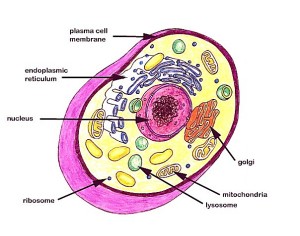The main nucleus function is to regulate or command the cell’s activities. Other than that, there are plenty of other important functions that a nucleus does. The nucleus is situated at the centermost part of the cell. It serves as the control hub of the entire cell. One of the primary nucleus functions is the generation of the deoxyribonucleic acids (DNA) which serves as a unique indicator of the being’s identity and something to be passed on to its offspring in the form of genes. The nucleus basically protects the genes that are bounded together in a chain like structure which is the DNA, and process these genes for proper functioning. It also serves to ensure that the copied genes are correctly transferred.
Structure of the Nucleus
In order to better comprehend the nucleus function, its structure should first be understood. The nucleus is basically the core of the cell. Some organisms have only one nucleus in their cells; others have plenty, while some don’t have any nucleus at all. The cells with one nucleus are termed as uninucleate, those cells with 2 or more nuclei are called multinucleate and the cells with no nucleus are referred to as enucleate. An example of an enucleate cell is the red blood cells.
The nucleus is often round or oval in shape and enclosed by a clear, jelly like fluid called the nuclear membrane. This membrane protects the nucleus from foreign material. Inside the nucleus are the chromatins, which are substances that appear thread like and contains the organism’s DNA and histones. When the time comes for cell division to take place, the chromatin would develop into chromosomes.
Aside from these, the other parts of the nucleus include the nucleolus, found amidst the chromatin threads, the ribonucleic acid and ribosomes, both of which play chief roles in the protein synthesis which is needed by the cell.
Functions of the Nucleus
The main nucleus function is to serve as the control center for all the activities within the cell. But apart from directing the cell’s activities, the nucleus serves as wide range of purposes as well making it truly essential in a living organism. Below are the different functions of the nucleus:
- The nucleus contains the genes essential for the development and growth of the organism. The main nucleus function is to ensure that uniformity of the replication of the DNA and the RNA is generated in order to be passed on inside the body so the body can perform its normal functions.
- There are three processes inside the nucleus that are required for the generation of DNA, namely, translation, transcription and replication. Each of these three basic processes plays an important role in the successful generation of a healthy DNA. Translation is the process wherein the mRNA is converted to amino acids. The amino acid is essential in the protein synthesis of the cell. Meanwhile, transcription is the conversion of RNA to DNA. And the final process, replication, is the copying of the exact DNA formed inside the nucleus before the cell divides. The replicas would then be distributed throughout the body.
- Protein synthesis also takes place within the nucleus. It is important for the body to have energy and protein in order for it to grow and develop normally. With protein synthesis, the growth of the cell is also ensured.
- The metabolism and synthesis of enzymes that would make up a protein is done inside the nucleus. Apart from this, the generation of energy needed for the cell activity is also a nucleus function. The metabolism of vitamins and nutrients is also conducted by the nucleus.
- The nucleus decides the amount of energy to be distributed or the level of energy that could pass through the membrane of the cell to control and ensure proper and normal cellular activity.
- The secretion or the discharge of ribosomes is another nucleus function. The ribosomes are very important in protein synthesis.
- In plants, the main nucleus function is to help in the photosynthesis or the process of the conversion of carbon dioxide to organic compounds for the plant’s consumption.
Basically, the nucleus function centers on the regulation of the entire cellular activity for the normal growth and development of the cell of the living organism. The nucleus contains the chromosomes and the DNA which are absolutely essential for the proper development of the organism. Furthermore, a healthy DNA would greatly help in delivering a healthy offspring. Without the nucleus, the translation, transcription and replication processes could go haywire producing incorrect replicates of the cell and would result to the poor functioning of the different cellular activities.
Having discussed the various nucleus functions, it is easy to understand why it is called the control center of the cell. The nucleus is a very small part of the cell, but it delivers dynamic and crucial tasks for the cell to properly function.
Nucleus diagram
Here is the diagram of nucleus along with other constituents of the cell.
